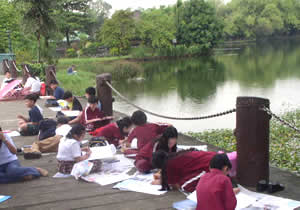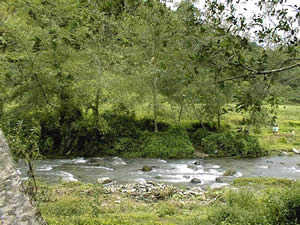|
|
|
|
|
|
|
|
importance of wetlands
|
HOME
| |
|
what are
wetlands? |
|
The Convention on Wetlands of International Importance or
RAMSAR Convention defines wetlands as
"areas of marsh, fen,
peatland or water, whether natural or artificial, permanent or temporary, with water that
is static or flowing, fresh, brackish or salt, including area of marine water the depth of
which at low tide does not exceed six meters" (Article
1.1).
The Convention text also stipulates that
wetlands:
"may incorporate riparian
and coastal zones adjacent to the wetlands, and islands or bodies of marine water deeper
than six meters at low tide lying within the wetlands"
(Article 2.1).
Wetland
types may be classified into coastal and
freshwater wetlands.
- Coastal wetlands include coral reefs, seagrass beds,
estuaries and mudflats, and mangroves.
- Freshwater wetlands include lakes, swamps and
marshes, river basins, reservoirs and dams.
|


|
|
back
to top

 |
|
importance of wetlands
Wetlands are part of our natural wealth and
have been critical to the development and survival of human communities. The
advancing technological skills of human communities may seem to have supplanted the role
of Nature, but recent environment catastrophes - floods, landslides, storms, many with
their roots in unsustainable land use practices - suggest otherwise.
the many functions of wetlands - |
 FLOOD CONTROL FLOOD CONTROL
Wetlands often play a crucial role in flood control. Loss of
floodplains to agriculture and human habitation has reduced this capacity.
Construction of levees and dams on rivers to improve flood control have often had the
reverse effect.
Floodplain restoration and removal of structures in providing a partial solution in
many countries.
|
 WATER PURIFICATION WATER PURIFICATION
 Plants
and soil in wetlands play a significant role in purifying water. High levels of
nutrients such as phosphorous and nitrogen, commonly associated with agricultural run-off,
are effectively removed by wetlands. This is important in preventing eutrophication
further downstream, a process that leads to rapid plant and algal growth followed by
depleted oxygen levels that affect other species. Plants
and soil in wetlands play a significant role in purifying water. High levels of
nutrients such as phosphorous and nitrogen, commonly associated with agricultural run-off,
are effectively removed by wetlands. This is important in preventing eutrophication
further downstream, a process that leads to rapid plant and algal growth followed by
depleted oxygen levels that affect other species.
It can also be important in preventing high
concentrations of these nutrients reaching groundwater supplies or other water sources
that may be used for drinking water.
|
|
 RESERVOIRS OF BIODIVERSITY RESERVOIRS OF BIODIVERSITY
 Wetlands, in general are home to a great diversity of species.
Although freshwater wetlands cover only 1% of the Earth's surface, they hold more than 40%
of the world's species and 12% of all animal species. Wetlands, in general are home to a great diversity of species.
Although freshwater wetlands cover only 1% of the Earth's surface, they hold more than 40%
of the world's species and 12% of all animal species.
On the marine front, coral reefs are among
the most biologically diverse of the land ecosystems. Although they cover only 0.2%
of the ocean floor, coral reefs may contain 25% of all marine species.
The
biodiversity in wetlands is also valuable as a reservoir of genes. Rice is a common
wetland plant and the staple diet for over half the world's population.
Some wetlands contain significant numbers
of endemic species.
|
|
 RECREATION / TOURISM RECREATION / TOURISM
 Many wetlands are prime locations for tourism, and some these sites
generate considerable income locally and nationally. Many wetlands are prime locations for tourism, and some these sites
generate considerable income locally and nationally.
Recreational activities such as fishing,
hunting and boating, involve millions of people who spend money for these activities.
Wetlands offer ideal locations for
involving the general public and schoolchildren in hands-on learning experiences, in an
essentially recreational atmosphere, to raise awareness of environmental issues.
|
|
 CULTURAL VALUE CULTURAL VALUE
 Although largely an unexplored,
poorly documented subject, wetlands are frequently of religious, historical,
archaeological or other cultural significance at the local or national level.
Although largely an unexplored,
poorly documented subject, wetlands are frequently of religious, historical,
archaeological or other cultural significance at the local or national level.
 In a preliminary survey of Ramsar
sites, over 30% of a sample of 603 Ramsar sites recorded some archaeological, historical,
religious mythological or cultural significance. In a preliminary survey of Ramsar
sites, over 30% of a sample of 603 Ramsar sites recorded some archaeological, historical,
religious mythological or cultural significance.
|
|
 GROUNDWATER REPLENISHMENT GROUNDWATER REPLENISHMENT
 An aquifer is a layer of rock containing water. Underground aquifers
store 97% of the world's unfrozen freshwater, and they provide drinking water to almost a
third of the world's population. Many wetlands help recharge
these underground aquifers. An aquifer is a layer of rock containing water. Underground aquifers
store 97% of the world's unfrozen freshwater, and they provide drinking water to almost a
third of the world's population. Many wetlands help recharge
these underground aquifers.
Groundwater is the only source
of water for many irrigation programs - 17% of the world's cropland is irrigated.
|
|
 SEDIMENT & NUTRIENT RETENTION AND EXPORT SEDIMENT & NUTRIENT RETENTION AND EXPORT
Wetlands tend to slow down the force of water, encouraging
the deposition of sediments carried in the water. This is beneficial further
downstream where deposition of sediments may block waterways. Nutrients are often
associated with sediments and can be deposited at the same time.
Nutrient retention in wetlands makes them
among the most productive recorded, rivaling even intensive agricultural systems.
Coastal deltas are dependent on riverine
sediments and nutrients for their survival; engineered structures that interfere with the
natural movement of sediments and nutrients can degrade deltas.
|
 SHORELINE STABILIZATION / STORM PROTECTION SHORELINE STABILIZATION / STORM PROTECTION
 Storm surges and other coastal weather disturbances can cause immense damage
through flooding and direct destruction of property, not to mention the loss of human
life. Storm surges and other coastal weather disturbances can cause immense damage
through flooding and direct destruction of property, not to mention the loss of human
life.
 Mangroves, marshes, and other coastal wetlands act as the frontline defense against
incoming storms. They help minimize the impact of storms by reducing wind action,
wave action and currents, while the roots of the plants help to hold the sediment in
place. Mangroves, marshes, and other coastal wetlands act as the frontline defense against
incoming storms. They help minimize the impact of storms by reducing wind action,
wave action and currents, while the roots of the plants help to hold the sediment in
place.
|
 CLIMATE CHANGE MITIGATION CLIMATE CHANGE MITIGATION
 Wetlands
may store as much as 40% of global terrestrial carbon; peatlands and other forested
wetlands are particularly important carbon sinks. Wetlands
may store as much as 40% of global terrestrial carbon; peatlands and other forested
wetlands are particularly important carbon sinks.
Conversion to agricultural use and
destruction of wetlands will release large quantities of carbon dioxide, the gas that
accounts 60% of the global warming effect.
|
 WETLAND PRODUCTS WETLAND PRODUCTS
 Wetlands provide a
variety of other benefits in the form of products that can be exploited for human
use. The range is enormous: fruit, fish, shellfish, crocodile and other meats,
timber for building, fuelwood, fodder for animals, etc.
Wetlands provide a
variety of other benefits in the form of products that can be exploited for human
use. The range is enormous: fruit, fish, shellfish, crocodile and other meats,
timber for building, fuelwood, fodder for animals, etc.
Exploitation is carried out in all levels -
subsistence level, cottage industry, and the larger commercial scale - in all parts of the
world. |
| |
| |
| |
| |
| |
| |
|
suggested site to visit . . .
 wetland values and functions
wetland values and functions |
|
|
|
|
|
|